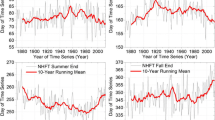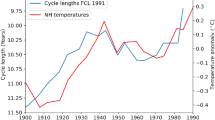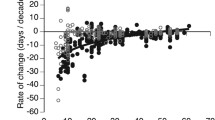Abstract
The growing season is considered by some to be a simple and yet significant indicator of the impact of hemispheric temperature variations at the local level. Yet, the effect of the use of different definitions of the growing season has never been determined.
In the present paper, time series of the length of differently defined growing seasons at four Wisconsin stations are compared. The results show that their lengths have fluctuated in a variety of patterns over the past 80 years. Two growing seasons which showed a significant trend did not agree on its direction. The reason for this disparity is that trends in maximum and minimum temperatures are not necessarily of the same sign at different times of the year. These findings suggest that the length of the growing season is not the simple climatic indicator it has been assumed to be.
Similar content being viewed by others
References
Angell, J. K., and Korshover, J.: 1975, ‘Estimate of the Global Change in Tropospheric Temperature Between 1958 and 1973’, Mon. Weather Rev. 103, 1007.
Brinkmann, W. A. R.: 1976, ‘Surface Temperature Trend for the Northern Hemisphere-Updated’, Quat. Res. (N.Y.) 6, 355.
Brinkmann, W. A. R.: 1979, ‘Associations Between Temperature Trends’, Ann. Assoc. J. Am. Geogr. 69, 250.
Brown, J. A.: 1976, ‘Shortening of growing season in the U.S. corn belt’, Nature (Lond.) 260, 420.
Bryson, R. A.: 1974, ‘A Perspective on Climatic Change’, Science 184, 753.
Bryson, R. A.: 1975, ‘The Lessons of Climatic History’, Environmental Conservation 2, 163.
Davis, N. E.: 1972, ‘The Variability of the Onset of Spring in Britain’, Q.J.R. Meteorol. Soc. 98, 763.
Davitaya, F. F.: 1965, ‘A Method of Predicting Heat Supply and Duration of the Growth Period’, Agric. Meteorol. 2, 109.
Gloyne, R. W.: 1973, ‘The ‘Growing season’ at Esksalemuir Observatory, Dumfriesshire’, Meteorol. Mag. 102, 174.
Lamb, H. H.: 1975, ‘Remarks on the Current Climatic Trend and its Perspective’, in: Long-Term Climatic Fluctuations (World Meteorological Organization, International Association of Meteorology and Atmospheric Physics Symposium, Norwich, England, August 1975), World Meteorological Organization, Geneva, 473.
Lamb, H. H.: 1977, Climate: Present, Past and Future. Volume 2: Climatic History and the Future, Methuen and Co. Ltd., London, p. 477.
Landsberg, H. E., and Albert, J. M.: 1975, ‘Some Aspects of Global Climatic Fluctuations’, Arch. Meteorol. Geophys. Bioklimatol., Ser. B 23, 165.
Levitt, J.: 1956, The Hardiness of Plants, Academic Press Inc., New York.
Mitchell, J. M., Jr.: 1961, ‘Recent Secular Changes of Global Temperature’, Ann. N.Y. Acad. Sci. 95, 235.
Mitchell, J. M. Jr.: 1966, Climatic Change, Technical Note No. 79, World Meteorological Organization, Geneva.
Moran, J. M. and Morgan, M. D.: 1977, ‘Recent Trends in Hemispheric Temperature and Growing Season Indices in Wisconsin’, Agric. Meteorol. 18, 1.
NRC: 1976, Climate and food, Committee on Climate and Weather Fluctuations and Agricultural Production, National Academy of Sciences, Washington.
NRC: 1977, The Atmospheric Sciences: Problems and Applications, Committee on Atmospheric Sciences, National Academy of Sciences, Washington.
Quenouille, M. H.: 1952, Associated Measurements, Butterworths Scientific Publications, London.
Ratcliffe, R. A. S., Weller, J., and Collison, P.: 1978, ‘Variability in the Frequency of Unusual Weather Over Approximately the Last Century’, Q.J.R. Meteorol. Soc. 104, 243.
Reitan, C. H.: 1974, ‘A Climatic Model of Solar Radiation and Temperature Change’, Quat. Res. (N.Y.) 4, 25.
Schaal, L. A., and Dale, R. F.: 1977, ‘Time of Observation Temperature Bias and “Climatic Change”’, J. Appl. Meteorol. 16, 215.
Thom, H. C. S. and Shaw, R. H.: 1958, ‘Climatological Analysis of Freeze Data for Iowa’, Mon. Weather Rev. 86, 251.
Thompson, L. M.: 1975, ‘Weather Variability, Climatic Change, and Grain Production’, Science 188, 535.
van Loon, H., and Williams, J.: 1976, ‘The Connection between Trends of Mean Temperature and Circulation at the Surface: Part III. Spring and Autumn’, Mon. Weather Rev. 104, 1591.
van Loon, H., and Williams, J.: 1978, ‘The Association between Mean Temperature and Interannual Variability’, Mon. Weather Rev. 106, 1012.
Wang, J. Y.: 1963, Agricultural Meteorology, Pacemaker Press, Milwaukee.
Winburne, J. H.: 1962, A Dictionary of Agricultural and Allied Terminology, Michigan State University Press, East Lansing.
Author information
Authors and Affiliations
Rights and permissions
About this article
Cite this article
Brinkmann, W.A.R. Growing season length as an indicator of climatic variations?. Climatic Change 2, 127–138 (1979). https://doi.org/10.1007/BF00133219
Received:
Revised:
Issue Date:
DOI: https://doi.org/10.1007/BF00133219




